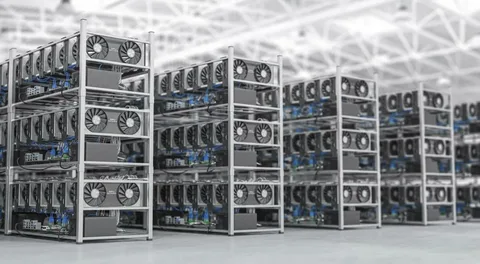There’s something strangely fascinating about how we’ve moved from gold rushes in dusty deserts to digital treasure hunts behind glowing computer screens. People once carried pickaxes and pans, but today, the tools of fortune are racks of humming machines tucked away in warehouses or even garages. That’s where the story of bitcoin miners begins—not with shovels and dirt, but with circuits, cooling fans, and algorithms.
I still remember when I first read about Bitcoin back in the early 2010s. It sounded like sci-fi—money you couldn’t touch, decentralized, and secured by cryptographic puzzles. At that time, a regular home computer could technically mine some coins. Fast-forward to now, and it’s become an entire industry where mining is as competitive as professional sports.
So, what exactly are these miners doing, and why are they so important? Let’s break it down in a way that feels a little less like a textbook and more like real life.
The Role of Bitcoin Miners
At their core, bitcoin miners are the backbone of the network. Without them, the entire blockchain would collapse. Each miner is essentially racing against others to solve cryptographic puzzles. These puzzles aren’t just for fun—they verify and secure transactions happening on the blockchain.
Imagine a global ledger that everyone can see, but no one controls. That’s Bitcoin. Every time a transaction happens, miners compete to confirm it, and whoever wins gets rewarded with Bitcoin. It’s like the digital version of being paid to keep the lights on in a massive financial system.
Why the Shift From Hobby to Industry?
If you tried running a small mining setup today, you’d quickly notice your electricity bill skyrocketing while your rewards trickle in. The difficulty level of mining has increased drastically over the years. Early adopters who mined with their laptops back in 2011 would laugh at the idea now.
These days, bitcoin miners rely on specialized hardware known as ASICs (Application-Specific Integrated Circuits). These aren’t your everyday computers. They’re machines built with one purpose: crunching Bitcoin’s algorithms as fast as possible while consuming as little power as they can. The competition is fierce, and the margins can be slim.
The Energy Debate
No conversation about mining would be complete without talking about energy consumption. Mining Bitcoin isn’t exactly eco-friendly, and this has sparked huge debates worldwide. Detractors argue that mining wastes massive amounts of energy, sometimes comparable to entire countries’ electricity use. Supporters counter that a lot of operations are moving toward renewable energy sources—solar farms, hydropower, even excess energy from oil fields.
The truth? It’s somewhere in the middle. Yes, bitcoin miners consume a lot of power, but the push toward sustainability is real. Personally, I think we’ll see more creative solutions pop up in the coming years, like using otherwise wasted energy or tapping into greener grids.
The Business Side of Mining
Mining isn’t just plugging in a machine and waiting for coins to fall into your wallet. It’s a business. You have to think about upfront hardware costs, electricity, maintenance, cooling systems, and of course, the volatility of Bitcoin’s price itself.
If Bitcoin’s price dips too low, some miners shut down their rigs because it’s not worth the expense. On the flip side, when prices skyrocket, the competition intensifies as everyone scrambles to turn a profit. That’s why many bitcoin miners operate in regions where electricity is cheaper or where governments offer incentives.
Risks and Rewards
Let’s be real—mining is not a guaranteed money-maker anymore. Gone are the days when anyone could mine a few bitcoins on their laptop and sit back while the value soared. Today, it’s a high-stakes game. The risks? Hardware could become obsolete quickly, electricity costs might eat up profits, and the market could tank.
But here’s the kicker: the rewards are still tempting. For those who get it right—efficient setups, cheap power, and smart planning—mining can still be very lucrative. Some operations rake in millions. And even small-scale miners sometimes stick with it out of passion rather than pure profit. It’s almost like a hobby for tech enthusiasts who love being part of the network.
Looking Ahead: The Future of Bitcoin Miners
The big question is: where do we go from here? With the halving events reducing rewards every four years, mining will inevitably become tougher. Smaller players might bow out, leaving massive farms to dominate the space. But decentralization is key to Bitcoin’s ethos, so I think there will always be room for innovative miners who find niche ways to stay competitive.
Some predict that bitcoin miners will increasingly rely on renewable power, and honestly, that feels inevitable. Others suggest mining might become a secondary activity tied to other industries—like heating homes with mining rigs or powering operations with leftover energy. It’s not far-fetched when you think about it.
A Personal Take on Mining’s Journey
What I love most about this whole world is how it blends technology, economics, and a bit of human ambition. There’s a thrill in knowing that behind every Bitcoin transaction, there’s a network of people (and machines) working tirelessly to keep it secure. Bitcoin miners may not get the same spotlight as investors or developers, but they’re the unsung heroes keeping the show running.
Whether you see mining as an opportunity, a gamble, or an environmental challenge, one thing is clear: it’s here to stay. Like the gold rush of old, not everyone will strike it rich, but the industry itself will continue to evolve, adapt, and shape the future of digital finance.
Why Mining Still Feels Like the Wild West
At the end of the day, mining Bitcoin isn’t a neatly packaged business—it’s messy, unpredictable, and constantly shifting. And maybe that’s what makes it so captivating. In a way, miners are today’s pioneers, chasing rewards in a digital frontier where the rules are still being written.



